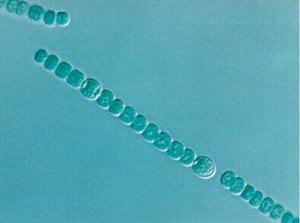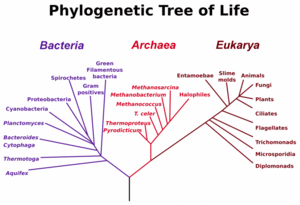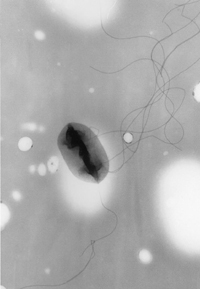Talk:Microorganism: Difference between revisions
imported>David Tribe |
imported>Subpagination Bot m (Add {{subpages}} and remove checklist (details)) |
||
| (10 intermediate revisions by 4 users not shown) | |||
| Line 1: | Line 1: | ||
{{subpages}} | |||
The gap from Leeuwenhoek to Pasteur is a very long one. When L is mentioned, Would it be better to talk about why L. did do than what he did not.?[[User:DavidGoodman|DavidGoodman]] 21:02, 24 November 2006 (CST) | The gap from Leeuwenhoek to Pasteur is a very long one. When L is mentioned, Would it be better to talk about why L. did do than what he did not.?[[User:DavidGoodman|DavidGoodman]] 21:02, 24 November 2006 (CST) | ||
:The statments that visible /invisible have exceptions occurs at least 5 times, 1 in each section. | :The statments that visible /invisible have exceptions occurs at least 5 times, 1 in each section. | ||
| Line 11: | Line 13: | ||
[[Image:Anabaena_heterocyst.jpg|frame|Filaments of joined cells the cyanbacterium ''Anabaena'' magnified about 4,000 times. In this prokayotic organism there are two types of cell. The occcasional cells that have a distinct appearance are 'heterocysts', specialized to fix nitrogen gas. [http://biology.plosjournals.org/perlserv/?request=get-document&doi=10.1371%2Fjournal.pbio.0040299 Cooperation among Microorganisms Ned S. Wingreen, Simon A. Levin PLoS Biol 4(9): e299. DOI:10.1371/journal.pbio.0040299 2006 ] ]] | [[Image:Anabaena_heterocyst.jpg|frame|Filaments of joined cells the cyanbacterium ''Anabaena'' magnified about 4,000 times. In this prokayotic organism there are two types of cell. The occcasional cells that have a distinct appearance are 'heterocysts', specialized to fix nitrogen gas. [http://biology.plosjournals.org/perlserv/?request=get-document&doi=10.1371%2Fjournal.pbio.0040299 Cooperation among Microorganisms Ned S. Wingreen, Simon A. Levin PLoS Biol 4(9): e299. DOI:10.1371/journal.pbio.0040299 2006 ] ]] | ||
'''Microorganism''' is the scientific word for germs. Germs are almost everywhere humans can venture, and in many places on the planet where we cannot ever go, but they are an invisible presence. | |||
Many people automatically assume germs are bad, because they cause infectious disease, but most germs (or microbes, as they are also called) are no pathogenic, and both the working of the living world and biological cycling of matter on earth, and human survival on intimately dependent on the diverse chemical activities of microbes. | |||
Another reason microbes are important is that all other life descended from them. Current scientific investigation of microbes are revealing clues about the earliest stages in evolution of life on earth which occurred some 4 billion years ago. Microbes are also important for teaching us about genetics, - the science of inheritance - because of the ease with which large numbers of them can be grown has enable biologists to work out the intricate details of inheritance in living cells, and led to discovery that DNA is the chemical through which traits are passed from generation to generation. | |||
Investigation of microbes and their genetic behavior led to a great flowering of the biological sciences during last century, starting in the mid-1940. | |||
| Line 16: | Line 28: | ||
The study of micro-organisms is called [[microbiology]]. | The study of micro-organisms is called [[microbiology]]. | ||
==Paragraph to introduce major types by illustative example== | |||
Less detail the better | |||
==Importance== | ==Importance== | ||
| Line 25: | Line 41: | ||
===Use in food=== | ===Use in food=== | ||
<ref>{{cite web |url=http://www.foodsci.uoguelph.ca/dairyedu/micro.html |title= Dairy Microbiology |accessdate=2006-10-09 |publisher= University of Guelph}}</ref> | <ref>{{cite web |url=http://www.foodsci.uoguelph.ca/dairyedu/micro.html |title= Dairy Microbiology |accessdate=2006-10-09 |publisher= University of Guelph}}</ref> | ||
lactobacilli = lactobacter? [[User:Robert Tito|Robert Tito]] | <span style="background:black"> [[<font color="red"><b>Talk</b></font>]] </span> | |||
=== Use in science === | === Use in science === | ||
| Line 30: | Line 48: | ||
== Microorganisms and human health == | == Microorganisms and human health == | ||
I'd like to add a whole section on normal flora- that's a concept that is really poorly conveyed in most health education. [[User:Nancy Sculerati MD|Nancy Sculerati MD]] 18:00, 17 March 2007 (CDT) | |||
=== Infectious disease === | === Infectious disease === | ||
| Line 62: | Line 80: | ||
===Fungi=== | ===Fungi=== | ||
==References== | ==References== | ||
Latest revision as of 19:02, 10 November 2007
The gap from Leeuwenhoek to Pasteur is a very long one. When L is mentioned, Would it be better to talk about why L. did do than what he did not.?DavidGoodman 21:02, 24 November 2006 (CST)
- The statments that visible /invisible have exceptions occurs at least 5 times, 1 in each section.
- The section on eukaryotic microorganisms neeeds to specifiy just what is included--a good trick--(my first research exerience was in protozoology, as it was then called). As you undoubtedly intend to include fungi, you'll have to explain that they are not plants. We should probably do a fngii article fairly early on. I'll start one from WP.DavidGoodman 20:51, 25 November 2006 (CST)
Complete rewrite
I think this article starts badly and is boring bland. I propose to start from scratch and De WP edia it. This will take time. I will do it so that access to the current one is preserved. An I am giving fair notice, in case there is disagreement. Im the only one to edit it here anyway. David Tribe 07:29, 17 March 2007 (CDT)
NEW DRAFT OF ARTICLE

Microorganism is the scientific word for germs. Germs are almost everywhere humans can venture, and in many places on the planet where we cannot ever go, but they are an invisible presence.
Many people automatically assume germs are bad, because they cause infectious disease, but most germs (or microbes, as they are also called) are no pathogenic, and both the working of the living world and biological cycling of matter on earth, and human survival on intimately dependent on the diverse chemical activities of microbes.
Another reason microbes are important is that all other life descended from them. Current scientific investigation of microbes are revealing clues about the earliest stages in evolution of life on earth which occurred some 4 billion years ago. Microbes are also important for teaching us about genetics, - the science of inheritance - because of the ease with which large numbers of them can be grown has enable biologists to work out the intricate details of inheritance in living cells, and led to discovery that DNA is the chemical through which traits are passed from generation to generation.
Investigation of microbes and their genetic behavior led to a great flowering of the biological sciences during last century, starting in the mid-1940.
Some unicellular protists and unusually large bacteria (Epulopiscium fishelsoni and Thiomargarita namibiensis) are visible to the naked eye [1]
The study of micro-organisms is called microbiology.
Paragraph to introduce major types by illustative example
Less detail the better
Importance
Habitats and ecology
Extremophiles
Use in food
lactobacilli = lactobacter? Robert Tito | [[Talk]]
Use in science
Microorganisms and human health
I'd like to add a whole section on normal flora- that's a concept that is really poorly conveyed in most health education. Nancy Sculerati MD 18:00, 17 March 2007 (CDT)
Infectious disease
Hygiene
History
Evolution
Discovery
Before Anton van Leeuwenhoek's invention of the microscope and discovery of microorganisms with it in 1676, Lazzaro Spallanzani and Louis Pasteur, ended the long-held belief that life could spontaneously appear from non-living substances.
Spallanzani found that microorganisms Pasteur ensured that there were no microorganisms alive in the broths at the start of his experiment. Nothing grew in the broths during his experiments, showing that the living organisms that grew in such broths came from outside, as spores on dust, rather than spontaneously generated within the broth. Thus, Pasteur decisively refuted the theory of spontaneous generation and supported germ theory.
In 1876, Robert Koch showed that microbes can cause disease, by showing that the blood of cattle that were infected with anthrax always contained large numbers of Bacillus anthracis.Koch's postulates. Though these postulates are no longer strictly accurate, they remain historically important in the development of scientific thought.

Classification
Bacteria
Archaea
Protists
Fungi
References
Citations
- ↑ Annu Rev Microbiol. 2001;55:105-37. Big bacteria. Schulz HN, Jorgensen BB.
- ↑ Dairy Microbiology. University of Guelph. Retrieved on 2006-10-09.
Further reading
- Dixon, Bernard (1994). Power Unseen: How Microbes Rule the World, 1st ed.. W. H. Freeman, Oxford and New York. ISBN 0-7167-4504-6.
- Krasner, Robert I. (2002). The Microbial Challenge: Human-Microbe Interactions, 1st.. ASM Press, Washington, DC. ISBN 0-13-144329-4.
- Knoll, Andrew H. (2003). Life on a Young Planet: the First Three Billion Years of Evolution on Earth, 1st ed.. Princeton University Press. ISBN 0-691-00978-3.
- Postgate, John (1992). Microbes and Man, 3rd ed.. Cambridge University Press, UK. ISBN 0-521-42355-4.
External links
- The largest bacteria
- Tree of Life
- Videos of bacteria swimming and tumbling, use of optical tweezers and other fine videos.
- More movies of growing bacteria
- Planet of the Bacteria by Stephen Jay Gould
- Major Groups of Prokaryotes
- Microbe News from Genome News Network
- BBC News, 28 September, 2001: The microbes that 'rule the world' Citat: "... The Earth's climate may be dependent upon microbes that eat rock beneath the sea floor, according to new research....The number of the worm-like tracks in the rocks diminishes with depth; at 300 metres (985 feet) below the sea floor, they become much rarer..."
- BBCNews: 16 January, 2002, Tough bugs point to life on Mars Citat: "...This research demonstrates that certain microbes can thrive in the absence of sunlight by using hydrogen gas..."
- BBCNews: 17 January, 2002, Alien life could be like Antarctic bugs
- Microbiology
